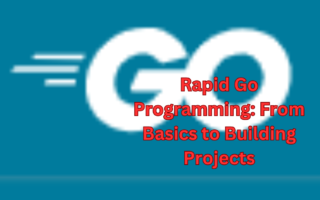This blog describes Variables and Data Types in Go.
In Go, variables are statically typed, which means that the type of a variable is determined at compile time and cannot change during runtime. Here’s an overview of variables and data types in Go.
Basic Data Types
- Numeric Types
int: Signed integer, size varies based on the platform (32 or 64 bits).int8,int16,int32,int64: Signed integers of specific sizes.uint: Unsigned integer, size varies based on the platform.uint8,uint16,uint32,uint64: Unsigned integers of specific sizes.uintptr: Unsigned integer type that is large enough to store the uninterpreted bits of a pointer value.float32,float64: Floating-point numbers.complex64,complex128: Complex numbers.
- Boolean Type
bool: Represents true or false values.
- String Type
string: Sequence of bytes, immutable.
Derived Data Types
- Array
array: Fixed-size collection of elements of the same type. Arrays in Go are declared using[size]type. The size of the array must be known at compile time.
- Slice
slice: Dynamic and flexible version of arrays. Slices are like references to arrays and are declared using[]type. They can grow or shrink as needed.
- Map
map: Unordered collection of key-value pairs. Maps are declared usingmap[keyType]valueType.
- Struct
struct: Composite data type that groups together variables of different types under a single name. Structs are declared using thetypeandstructkeywords.
- Pointer
pointer: Variables that store the memory address of another variable. Pointers are declared using the*symbol followed by the type of the variable it points to.
Type Conversion
Go requires explicit type conversion when converting between types. Type conversion is done using syntax like typeName(expression).
Zero Values
Variables in Go are automatically assigned a “zero value” if not explicitly initialized. Zero values depend on the type of the variable. For example, the zero value of an int is 0, and the zero value of a string is an empty string "".
Constants
Constants are like variables, but their values cannot be changed after they are declared. Constants are declared using the const keyword.
Example
package main
import "fmt"
func main() {
// Numeric types
var i int = 42
var f float64 = 3.14
var b bool = true
var s string = "Hello, Go!"
// Derived types
var arr [3]int = [3]int{1, 2, 3}
var slice []int = []int{4, 5, 6}
var m map[string]int = map[string]int{"a": 1, "b": 2}
type Person struct {
Name string
Age int
}
var p Person = Person{Name: "Alice", Age: 30}
var ptr *int = &i
// Printing values
fmt.Println(i, f, b, s)
fmt.Println(arr, slice, m, p, *ptr)
}
Output

Further Reading
Program Structure in Go Programming Language
Spring Framework Practice Problems and Their Solutions
How to Create and Run a Simple Program in Go?
20+ Interview Questions on Go Programming Language
From Google to the World: The Story of Go Programming Language
Why Go? Understanding the Advantages of this Emerging Language
Creating and Executing Simple Programs in Go
- Angular
- ASP.NET
- C
- C#
- C++
- CSS
- Dot Net Framework
- HTML
- IoT
- Java
- JavaScript
- Kotlin
- PHP
- Power Bi
- Python
- Scratch 3.0
- TypeScript
- VB.NET

